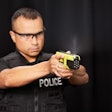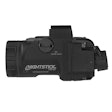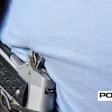The use of backup guns is becoming more and more common with American law enforcement personnel. The reasons for carrying a backup gun are simple: If your primary weapon is snatched, runs out of ammo, or malfunctions you don't have to face your attacker(s) with only a less-lethal weapon or harsh language. You draw your backup gun and get back into the fight.
Many agencies allow their officers to carry a backup gun, while others require it. The most popular types of backup guns are small revolvers and semi-auto pistols, and SIG Sauer has just introduced a small semi-auto that deserves a serious look from any officer or agency considering such weapons: the P238.
In addition to being used for backup, the P238 would be very practical for plainclothes officers who need a "deep cover" weapon. It would also be a good choice for an off-duty gun. Not only do many agencies allow or even encourage off-duty carry, but some (e.g. the NYPD) require their officers to be armed at all times. This pistol will satisfy this requirement, too.
1911 Looks
Unlike so many of the new pistols on today's market, the P238 does not make use of a polymer frame or components and does not have a double-action-only trigger. Instead, this very traditional pistol uses a stainless steel frame mated to an alloy frame and has a single-action trigger mechanism with an external, thumb safety. In fact, a cursory examination of the SIG reveals that it is nothing more than a (very) mini 1911.
But while the P238 is a 1911 clone externally, when you disassemble the pistol you find the barrel locks up via the chamber hood moving up into, and bearing on, the front of the ejection port as the slide reciprocates rearward. This is a much simpler locking system than the 1911's lugs on the barrel, and SIG was one of the first companies to use this system in its pistols.
Operation and Carry
The operating drill for the P238 is the same as the 1911. You insert a magazine, rack the slide to chamber a cartridge, and then engage the thumb safety. The pistol can be carried this way (condition 1), which allows you to draw and fire it very quickly and accurately.
If you don't care for this mode of carry, you can carry it with a loaded magazine, chamber empty and the hammer down (condition 3), which requires you to rack the slide to chamber a round before it can be fired. Both modes have their proponents and critics, but with proper training the single-action 1911-type pistol is one of the safest handguns ever designed.
The P238 is chambered for the popular .380 ACP. This round has been around since 1912 and while it was once considered a low-end defensive cartridge, its performance has been significantly improved thanks to advances in bullet technology and modern propellants. I'm not saying it's the equal of the .40 S&W, but I'm sure most would agree that it sure beats the hell out of a baton as a backup to your duty pistol.
On the Range
SIG Sauer's Kathy McQueeney kindly supplied me with a P238 to evaluate for POLICE magazine. As you would expect from a company with SIG Sauer's reputation, the P238 displayed first class materials, fit, and finish. The slide was easy to retract, the controls all worked positively, and the sights and ergonomics were above average for this class of pistol.
While it is hardly germane for a pistol of this size, I test fired it for accuracy from a rest at 10 yards with UMC 95-grain FMJ ammo. I was pleased to see that, despite the P238's small size and short grip, I was able to produce decently centered groups running from just under three inches to four inches in size.
My good friend Paul Brinkman, a former firearms training officer for the Riverside County (Calif.) Sheriff's Department, helped me run the little SIG through its paces at our gun club. Using a mixture of the remaining ammo, we ran a series of drills at three, five, and seven yards, firing the pistol with both supported and unsupported grips. All drawing was done from concealment using a Galco IWB holster.
As both of us compete regularly in Action Pistol matches with 1911 pistols, we found the little P238's operating drill almost second nature...just a bit smaller. Or as my friend Paul put it, "It's really nice having all the controls located and operated exactly as you're used to them." The magazines dropped free when the release was pushed-slide forward or locked back.
The sights were large and easy to pick up, which enabled both of us to perforate targets in a very pleasing manner while the controls were well located and convenient to manipulate. We were both surprised with how controllable recoil was in a pistol weighing only 15 ounces. Both of us were able to get back on target quickly and make accurate follow-up shots with aplomb.
We ran about 300 rounds of FMJ and JHP rounds through it with utter reliability. In fact, the only functioning problem we experienced were a few failures of the slide to lock back on an empty magazine. But this was a new, out-of-the-box pistol and I would expect such minor problems to clear up once it is broken in.
On the Street
I used the P238 as my regular concealed carry gun for several weeks and can report that it served admirably in this role. Its flat cross-section made it easy to conceal even under light clothing and thanks to its light weight I was hardly aware that I was carrying a gun.
Whether you are a uniformed officer looking for a backup gun, a detective who needs a small handgun for deep concealment, or a cop who needs an off-duty gun that is easy to carry when wearing civilian clothing, I believe the P238 would be a very practical choice.
Paul Scarlata has served as an auxiliary police officer and is a frequent contributor to POLICE.

















